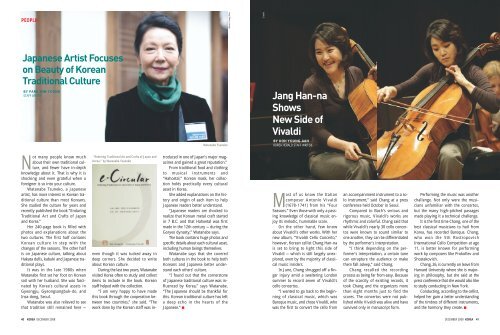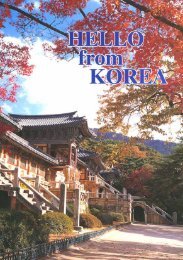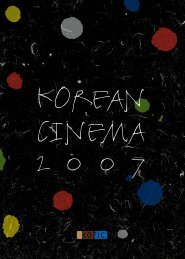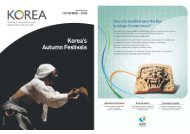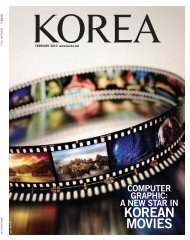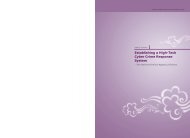Seoul Lights Up for the Holiday Season - Korea.net
Seoul Lights Up for the Holiday Season - Korea.net
Seoul Lights Up for the Holiday Season - Korea.net
You also want an ePaper? Increase the reach of your titles
YUMPU automatically turns print PDFs into web optimized ePapers that Google loves.
PEOPLE<br />
Moon Young Doo<br />
Credia<br />
Japanese Artist Focuses<br />
on Beauty of <strong>Korea</strong>n<br />
Traditional Culture<br />
BY PARK MIN-YOUNG<br />
STAFF WRITER<br />
Watanabe Tsuneko<br />
Jang Han-na<br />
Shows<br />
New Side of<br />
Vivaldi<br />
BY KOH YOUNG-AAH<br />
KOREA HERALD STAFF WRITER<br />
Not many people know much<br />
about <strong>the</strong>ir own traditional culture,<br />
and fewer have in-depth<br />
knowledge about it. That is why it is<br />
shocking and even grateful when a<br />
<strong>for</strong>eigner is so into your culture.<br />
Watanabe Tsuneko, a Japanese<br />
artist, has more interest in <strong>Korea</strong>n traditional<br />
culture than most <strong>Korea</strong>ns.<br />
She studied <strong>the</strong> culture <strong>for</strong> years and<br />
recently published <strong>the</strong> book “Enduring<br />
Traditional Art and Crafts of Japan<br />
and <strong>Korea</strong>.”<br />
Her 240-page book is filled with<br />
photos and explanations about <strong>the</strong><br />
two cultures. The first half contains<br />
<strong>Korea</strong>n culture in step with <strong>the</strong><br />
changes of <strong>the</strong> seasons. The o<strong>the</strong>r half<br />
is on Japanese culture, talking about<br />
Hakata dolls, kabuki and Japanese traditional<br />
plays.<br />
It was in <strong>the</strong> late 1980s when<br />
Watanabe first set her foot on <strong>Korea</strong>n<br />
soil with her husband. She was fascinated<br />
by <strong>Korea</strong>’s cultural assets in<br />
Gyeongju, Gyeongsangbuk-do, and<br />
Insa-dong, <strong>Seoul</strong>.<br />
Watanabe was also relieved to see<br />
that tradition still remained here —<br />
“Enduring Traditional Art and Crafts of Japan and<br />
<strong>Korea</strong>,” by Watanabe Tsuneko<br />
even though it was tucked away in<br />
deep corners. She decided to write<br />
about <strong>Korea</strong>n culture.<br />
During <strong>the</strong> last two years, Watanabe<br />
visited <strong>Korea</strong> often to study and collect<br />
items to include in <strong>the</strong> book. <strong>Korea</strong>n<br />
staff helped with <strong>the</strong> collection.<br />
“I am very happy to have made<br />
this book through <strong>the</strong> cooperation between<br />
two countries,” she said. “The<br />
work done by <strong>the</strong> <strong>Korea</strong>n staff was introduced<br />
in one of Japan’s major magazines<br />
and gained a great reputation.”<br />
From traditional food and clothing<br />
to musical instruments and<br />
“Hahoetal,” <strong>Korea</strong>n mask, her collection<br />
holds practically every cultural<br />
asset in <strong>Korea</strong>.<br />
She added explanations on <strong>the</strong> history<br />
and origin of each item to help<br />
Japanese readers better understand.<br />
“Japanese readers are shocked to<br />
realize that <strong>Korea</strong>n metal craft started<br />
in 7 B.C. and that Hahoetal was first<br />
made in <strong>the</strong> 12th century — during <strong>the</strong><br />
Goryeo dynasty,” Watanabe says.<br />
The book contains huge photos and<br />
specific details about each cultural asset,<br />
including human beings <strong>the</strong>mselves.<br />
Watanabe says that she covered<br />
both cultures in <strong>the</strong> book to help both<br />
<strong>Korea</strong>ns and Japanese better understand<br />
each o<strong>the</strong>rs’ culture.<br />
“I found out that <strong>the</strong> cornerstone<br />
of Japanese traditional culture was influenced<br />
by <strong>Korea</strong>,” says Watanabe.<br />
“The Japanese should be thankful <strong>for</strong><br />
this. <strong>Korea</strong>n traditional culture has left<br />
a deep echo in <strong>the</strong> hearts of <strong>the</strong><br />
Japanese.” ■<br />
Most of us know <strong>the</strong> Italian<br />
composer Antonio Vivaldi<br />
(1678-1741) from his “Four<br />
<strong>Season</strong>s.” Even those with only a passing<br />
knowledge of classical music enjoy<br />
its melodic, hummable score.<br />
On <strong>the</strong> o<strong>the</strong>r hand, few know<br />
about Vivaldi’s o<strong>the</strong>r works. With her<br />
new album, “Vivaldi Cello Concerto,”<br />
however, <strong>Korea</strong>n cellist Chang Han-na<br />
is set to bring to light this side of<br />
Vivaldi — which is still largely unexplored,<br />
even by <strong>the</strong> majority of classical<br />
music insiders.<br />
In June, Chang shrugged off a finger<br />
injury amid a sweltering London<br />
summer to record seven of Vivaldi’s<br />
cello concertos.<br />
“I wanted to go back to <strong>the</strong> beginning<br />
of classical music, which was<br />
Baroque music, and chose Vivaldi, who<br />
was <strong>the</strong> first to convert <strong>the</strong> cello from<br />
an accompaniment instrument to a solo<br />
instrument,” said Chang at a press<br />
conference held October in <strong>Seoul</strong>.<br />
Compared to Bach’s serious and<br />
rigorous music, Vivaldi’s works are<br />
rhythmic and colorful. Chang said that<br />
while Vivaldi’s nearly 30 cello concertos<br />
were known to sound similar to<br />
one ano<strong>the</strong>r, <strong>the</strong>y can be differentiated<br />
by <strong>the</strong> per<strong>for</strong>mer’s interpretation.<br />
“I think depending on <strong>the</strong> per<strong>for</strong>mer’s<br />
interpretation, a certain tune<br />
can enrapture <strong>the</strong> audience or make<br />
<strong>the</strong>m fall asleep,” said Chang.<br />
Chang recalled <strong>the</strong> recording<br />
process as being far from easy. Because<br />
of <strong>the</strong> scarcity of existing records, it<br />
took Chang and <strong>the</strong> organizers more<br />
than eight months just to find <strong>the</strong><br />
scores. The concertos were not published<br />
while Vivaldi was alive and have<br />
survived only in manuscript <strong>for</strong>m.<br />
Per<strong>for</strong>ming <strong>the</strong> music was ano<strong>the</strong>r<br />
challenge. Not only were <strong>the</strong> musicians<br />
unfamiliar with <strong>the</strong> concertos,<br />
but <strong>the</strong> many high-pitched passages<br />
made playing it a technical challenge.<br />
It is <strong>the</strong> first time Chang, one of <strong>the</strong><br />
best classical musicians to hail from<br />
<strong>Korea</strong>, has recorded Baroque. Chang,<br />
who won <strong>the</strong> 5th Rostropovich<br />
International Cello Competition at age<br />
11, is better known <strong>for</strong> per<strong>for</strong>ming<br />
work by composers like Prokofiev and<br />
Shostakovich.<br />
Chang, 26, is currently on leave from<br />
Harvard University where she is majoring<br />
in philosophy, but she said at <strong>the</strong><br />
press conference that she would also like<br />
to study conducting in New York.<br />
Conducting, according to <strong>the</strong> cellist,<br />
helped her gain a better understanding<br />
of <strong>the</strong> timbres of different instruments,<br />
and <strong>the</strong> harmony <strong>the</strong>y create. ■<br />
40 KOREA DECEMBER 2008<br />
DECEMBER 2008 KOREA 41


